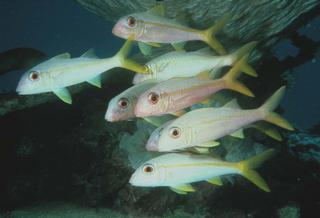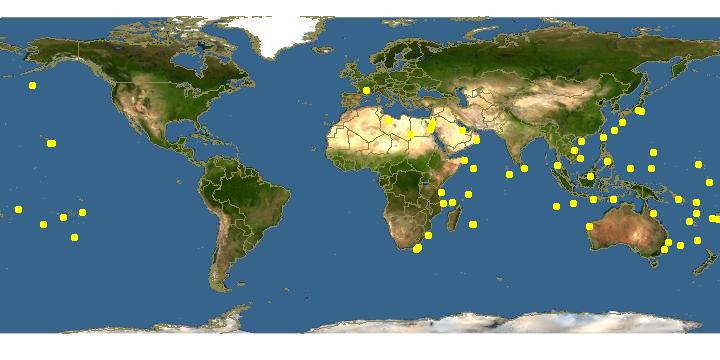|
| Links |
We parsed the following live from the Web into this page. Such content is managed by its original site and not cached on Discover Life. Please send feedback and corrections directly to the source. See original regarding copyrights and terms of use.
- Australian Faunal Directory
- FishBase
|
|
español |
|
|
Overview |
Main identification features
- yellow stripe
- yellow tail fin
- gill rakers: 33
- pectoral: 17 rays
Dorsal fin VIII + I, 8 (first dorsal spine minute, often imbedded); anal rays I-II, 6; pectoral rays 16-17 (usually 17), fin length 19.2-23.2% (average 21.1%) of standard length; barbel length 20-26% (average 22.9%) of standard length; gill rakers 31-36 (average 33); lateral line scales 36-42.
Body silvery white with a blue-edged yellow stripe along its center; tail and other median fins yellow.
Size: reaches 31 cm.
Habitat: rocky and Coral reefs and adjacent sand areas.
Depth: 2-115 m.
Widespread throughout the Indo-central Pacific. While it was not thought to occur in the tropical eastern Pacific its occurrence there was demonstrated by genetic analysis. Very similar to M. dentatus, but differs in having more pectoral fin rays, a slightly longer pectoral fin, slightly longer barbels and more gill rakers. These differences are so slight that in practice it is probably not possible to separate all individals of the two species when they are together at the same location.
Attributes
Abundance: Common.
Cites: Not listed.
Climate Zone: Northern Subtropical (Cortez Province + Sinaloan Gap); Equatorial (Costa Rica to Ecuador + Galapagos, Clipperton, Cocos, Malpelo).
Depth Range Max: 115 m.
Depth Range Min: 2 m.
Diet: mobile benthic worms; mobile benthic crustacea (shrimps/crabs); mobile benthic gastropods/bivalves; bony fishes.
Eastern Pacific Range: Northern limit=24; Southern limit=8; Western limit=-110; Eastern limit=-82; Latitudinal range=16; Longitudinal range=28.
Egg Type: Pelagic; Pelagic larva.
Feeding Group: Carnivore.
FishBase Habitat: Reef Associated.
Global Endemism: All Pacific (West + Central + East); Indo-Pacific only (Indian + Pacific Oceans); TEP non-endemic; "Transpacific" (East + Central &/or West Pacific); All species.
Habitat: Corals; Reef associated (reef + edges-water column & soft bottom); Rocks; Soft bottom (mud, sand,gravel, beach, estuary & mangrove); Sand & gravel; Reef (rock &/or coral); Reef and soft bottom.
Inshore Offshore: Inshore; Inshore Only.
IUCN Red List: Not evaluated / Listed.
Length Max: 31 cm.
Regional Endemism: Island (s); Continent; Continent + Island (s); Tropical Eastern Pacific (TEP) non-endemic; Eastern Pacific non-endemic; All species.
Residency: Resident.
Salinity: Marine; Marine Only.
Water Column Position: Bottom; Bottom only;
|
|
|
Names | |
|
|
|
Links to other sites | |
|
|
|
References |
- Cuvier , G. and Valenciennes, A., 1831., Histoire naturelle des poissons. Tome septième. Livre septième. Des Squamipennes. Livre huitième. Des poissons à pharyngiens labyrinthiformes., Histoire Naturelle Des Poissons, 7:1-531.
- Love, M.S., Mecklenburg, C.W., Mecklenburg, T.A., Thorsteinson, L.K., 2005., es of the West Coast and Alaska: a checklist of North Pacific and Artic Ocena species from Baja California to the Alaska-Yukon border., U.S. Department of the Interior, U.S. Geological Survey, Biological Resources Division, 288pp.
- Stefien , C. A. , Randall , J. E. and Rosenblatt, R. H., 1994., Genetic and morphological divergence of a circumtropical complex of goatfishes: Mulloidichthys vanicolensis, M. dentatus, and M. martinicus., Pac. Sci., 48:44-56.
|
|
|
Acknowledgements | |
I thank Ashley MacDonald and John Pickering, University of Georgia, for technical support in building this page.
|
|
| Supported by | |
|
Following modified from Australian Faunal Directory
|
Top | See original
| &pull 20q v5.145 20180528: Error 301 Moved Permanently http://biodiversity.org.au/afd/taxa/dac9b5fb-b9ee-4e46-8747-cc6c8493adf5 |
|
Following modified from FishBase
|
Top | See original
http://www.fishbase.org/Summary/speciesSummary.php?genusname=Mulloidichthys&speciesname=vanicolensis ---> http://192.134.151.83/Summary/speciesSummary.php?genusname=Mulloidichthys&speciesname=vanicolensis
http://192.134.151.83/Summary/speciesSummary.php?genusname=Mulloidichthys&speciesname=vanicolensis ---> https://fishbase.mnhn.fr/Summary/speciesSummary.php?genusname=Mulloidichthys&speciesname=vanicolensis
&pull 20q v5.145 20180528: Error 501 Protocol scheme 'https' is not supported (LWP::Protocol::https not installed) https://fishbase.mnhn.fr/Summary/speciesSummary.php?genusname=Mulloidichthys&speciesname=vanicolensis |
Updated: 2024-04-16 11:36:13 gmt
|

